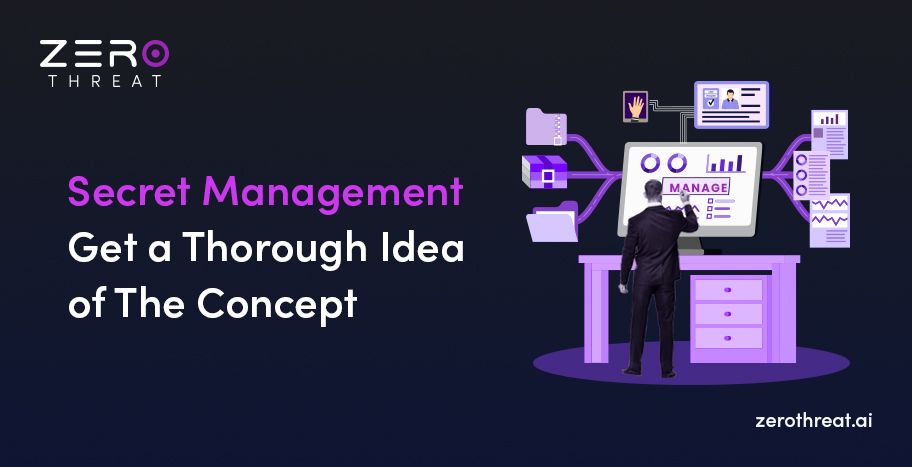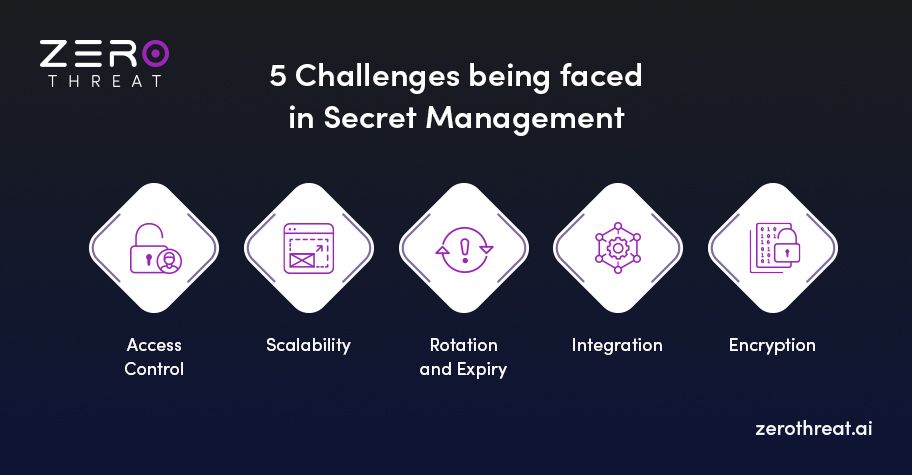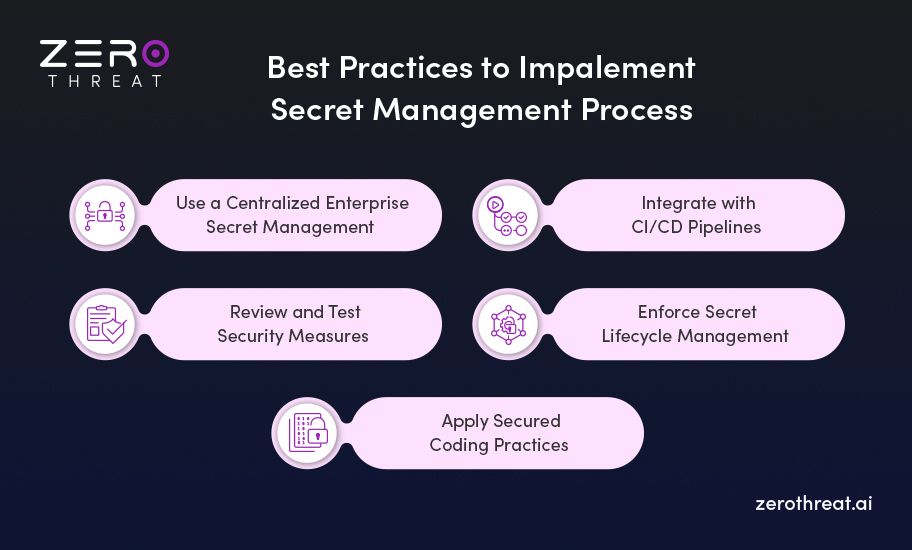All Blogs

Blog Overview: Your digital data is not less than diamonds for you in today's time. It can be optimized and exploited both. That's why ensuring its robust security is a must. In this blog, we are going to talk about a secret management process that helps you safeguard your confidential information from unauthorized access. Read this further to learn how secret management works and what its challenges and practices are to achieve high-powered security.
Managing secrets effectively is essential for keeping your sensitive data safe and ensuring your applications run smoothly. By adopting strong secret management practices, you can protect important credentials, API keys, and encryption secrets. As a result, it lowers the risk of unauthorized access and potential breaches in your organization.
Well, secret management solutions play a massive role in revamping the security of your overall digital assets.
Wondering what secret management is?
Fret not, folks!
This insightful piece is going to be of huge help to reduce the risk of potential vulnerabilities. So, give it a read to unlock the key to robust security for your confidential data.
Assess All the Vulnerable Spots of Your Applications Within Minutes Sign up For Advanced Assessment
Table of Contents
- What is Secret Management and How Does It Work?
- Critical Challenges of Secret Management
- Best Practices for Implementing Unfailing Secret Management Process
- Top Secret Management Tools
- How ZeroThreat can Help you Implement Secret Management Solutions?
What is Secret Management and How Does It Work?
Secret management is the process of managing and securing confidential data such as passwords, API keys, and certificates to ensure foolproof security and privacy in order to prevent unauthorized access.
Imagine you are developing a web application that connects to a cloud database. To access this database, your application requires a connection string that comprises sensitive details such as the database credentials. Storing this connection string directly in the code of your application or configuration files is quite risky. If anyone manages to obtain access to these files, they can also gain access to your database.
To manage this effectively and securely, you would use a secret management process. Here's how secret management solutions work:
1. Storing Secrets
You can securely store the database credentials using secret management tools like AWS Secrets Manager, Azure Key Vault, and HashiCorp Vault. The secretive data is encrypted and stored in a secure, centralized location.
2. Access Control
Secret management tools ensure that only authenticated users can access the sensitive data. With secret management, permissions and roles are predetermined for controlling, accessing, reading, writing, or managing secrets.
3. Rotation
The secret management process involves changing and updating secrets regularly (e.g., updating passwords or API keys) to minimize the risk of unauthorized access and data breaches if the secret data is compromised. Automated tools perform secret scanning to avoid accidental data exposure. Also, they help manage and rotate secrets.
4. Auditing and Monitoring
By implementing the secrets management best practices, you can regularly track accessibility and changes in secret data to assess and respond to potential vulnerabilities. Also, logs and alerts help detect malicious activities.
5. Integration
Secrets management systems easily integrate with applications and infrastructure to securely provide secrets when required by managing their privacy in code or configuration files.
5 Critical Challenges of Secret Management
Let's discover the biggest challenges businesses face while implementing secret management practices.

1. Access Control
Managing access is the most crucial part of the secret management system. It ensures that the data is only accessible to authorized users and systems for modification and retrieval. However, setting up and managing strict permissions is quite a complex job as the number of users and systems constantly increases. Effective access control system integrates effortlessly with existing identities and access management systems to ensure that restrictions and permissions are effectively working.
Balancing seamless access for authenticated users while protecting secrets from potential threats is a significant aspect of this challenge.
2. Scalability
As enterprises grow, so does the quantity of confidential information. This growth leads to challenges in tracking and managing a higher volume of confidential data across different services and environments. A scalable secret management tool is a prerequisite to manage accommodating new applications, services, and infrastructure components without compromising performance efficiency.
3. Rotation and Expiry
In the secret management process, secrets, such as passwords or API keys, are periodically rotated to reduce security risks in websites and apps. Automating the entire process, along with managing the functionality of the system, is a challenging task. Secrets need to be updated without causing disruptions, which requires heedful coordination and testing.
4. Integration
Integration of secret management solutions with multiple apps, systems, platforms, and environments is a very complex task. Each system has unique requirements or interfaces. In such cases, ensuring that the secret management solution runs smoothly across all of them needs meticulous configuration and sometimes custom development. This gives rise to the challenge of compatibility, as it's vital to ensure that secrets are securely managed and accessible where needed.
5. Encryption
The key requirement of secretive data is airtight security. Ensuring robust encryption methods is undoubtedly important, both when they are stored (at rest) and when they are being transmitted (in transit). This involves managing encryption keys, which themselves must be highly secured and rotated uniformly. Steadfast encryption practices are critical for protecting secrets, but they also add an extra layer of complexity to the secret management process.
Optimize a Scalable Secret Scanning Tool to Attain Airtight Security for your Data Get Premium Scan for Free
5 Best Practices for Implementing Unfailing Secret Management Process

1. Use a Centralized Enterprise Secret Management
Centralizing secrets in a single management system is critical for managing control and security. A centralized secret management system enables you to store, manage, and audit secrets in one place, streamlining the entire process. This approach also ensures that access to secrets is regulated consistently, making it easier to implement security policies and track usage.
Moreover, a centralized secret management system offers features like encryption, access control, and auditing, which help safeguard sensitive information and simplify secret handling.
2. Integrate with CI/CD Pipelines
Incorporating secret management with Continuous Integration/Continuous Deployment (CI/CD) pipelines allows organizations to ensure that secrets are managed securely throughout the development and deployment process. This integration enables the secure retrieval and use of secrets during automated builds and deployments, maintaining their secrecy in logs or artifacts. Proper integration requires diligent configuration to prevent accidental data exposure and to maintain the security of secrets throughout the pipeline.
3. Review and Test Security Measures
Backing up your secret management system is very important for data protection and continuity. Consistently build backups of secrets and ensure that storage is secured and protected from unauthorized access. Having a well-defined recovery plan in place enables you to easily restore secrets if you lose your data or a system fails.
4. Enforce Secret Lifecycle Management
Effective secret lifecycle management defines and implements policies for how secrets should be managed till they exist. This involves setting expiration dates, taking care of the transition of secrets as they become outdated, and ensuring that they are replaced or revoked whenever required. Having a seamless process for the lifecycle of secrets helps organizations keep track of obsolete or compromised secrets to prevent potential vulnerability risks and ensure the robust security of systems.
5. Apply Secured Coding Practices
Secure coding practices are indispensable to prevent the exposure of sensitive details through application code. Secrets should not be hardcoded directly into source code or configuration files, as this can increase the chances of accidental data leakage. Instead, optimize secure methods to retrieve secrets at runtime, such as through environment variables or secure configuration management tools. Ensuring that secrets are managed securely during the development and deployment process helps to safeguard them from unauthorized access and minimizes the risk of accidental breaches.
Top 4 Secret Management Tools
Let's explore the top-secret management tools of 2026 to achieve never-failing confidential data security.
1. HashiCorp Vault
Overview: A robust, open-source tool created for secrets management, encryption, and access control.
Key Features:
- Secret Management
- Dynamic Secrets
- Encryption as a Service
- Access Control Policies
- Authentication Methods
- Audit Logging
- Secret Leasing and Renewal
- High Availability
- Secret Visioning
- Secret Revocation
2. AWS Secret Manager
Overview: A managed service by Amazon Web Services that allows organizations to securely store, retrieve, and manage secrets.
Key Features:
- Secret Management
- Automatic Rotation
- Integrated with AWS Services
- Fine-Grained Access Control
- Secret Versioning
- Audit Logging
- Encryption at Rest and in Transit
- Cross-Region Replication
- Secrets Retrieval via API
3. Azure Key Vault
Overview: A Microsoft Azure service for managing secrets, keys, and certificates.
Key Features:
- Key Management
- Secrets Management
- Certificate Management
- Secure Storage
- Access Policies
- Integration with Azure Services
- Encryption at Rest and in Transit
- Compliance and Security Certifications
- Versioning of Secrets and Keys
4. Google Cloud Secret Manager
Overview: A fully managed service by Google Cloud for securely handling and accessing secrets.
Key Features:
- Versioning
- Automatic Rotation
- Secure Storage
- Access Control
- Audit Logging
- Integration with Google Cloud Services
- API-Based Access
- IAM Integration
- Secret Replication Across Regions
- Access via Google Cloud Console
Assess Dangerous Vulnerable Corners of Your Digital Assets with 91% Accuracy Take a Free Tour
How ZeroThreat can Help you Implement Secret Management Solutions?
Proper secret management solutions help you mitigate the risk of unauthorized access to your confidential information. We hope this blog provides you with all the required solutions for your secret management.
But here's one fringe benefit for you now that you have reached the concluding stage of this blog! It’s ZeroThreat! It is an advanced secret scanning tool that is a master at detecting sensitive information, including passwords, API keys, access tokens, certificates, and other confidential data, across all files in your repositories and delivery pipelines.
With an unbelievably fast speed and accuracy, it alleviates the complexity of performing painstaking process scanning and security testing for your web apps and APIs.
All you need to do is sign up for this advanced security testing and scanning tool and discover its miraculous performance in assessing vulnerabilities from every corner of the system.
Frequently Asked Questions
Why is it important to update secrets?
Updating secrets is necessary to maintain security because it reduces the risk of unauthorized access and potential breaches, as secrets like passwords, API keys, and access tokens can be compromised. Thus, uniformly updating them ensures that any potentially leaked or outdated credentials do not reveal malicious actors' prolonged access to your systems.
What is secret key?
What is a secret management system?
Explore ZeroThreat
Automate security testing, save time, and avoid the pitfalls of manual work with ZeroThreat.


